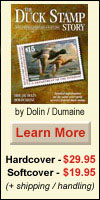 |
10% off on
web orders over $100 |
|
|

|
|
Federal designs have some interesting stories Ė trivia
There are a number of interesting but little-known facts about several United States federal duck stamps. As a country consumed by trivia, (can you say "Regis?") some fun facts can really add to the depth of enjoyment of your collection.
For instance Ö the design of the second federal stamp, the $1 Canvasbacks Taking Flight of 1935 (RW2) shows a hunter with gun, boat and blind. However, the original artwork does not show these elements. All that can be seen is a dark blob in the same area.
Why was this detail not present on the artist's submission?
The acclaimed artist, Frank W. Benson, was known as the dean of wildlife etchers. The sketchy artwork he submitted for the federal stamp was, with Bensonís permission, embellished by artists at the Bureau of Engraving and Printing to include details of the hunting scene.
This 1935 issue is the only federal duck stamp that shows a gun, however vague, in the design.
The $1 Pintail Drake and Hen Alighting stamp of 1938 by Roland Clark (RW5) also began as an etching and depicted five pintails. However, his original work was modified, and the plate was cropped prior to preparation of the stamp, reducing the number of ducks illustrated to just two.
Sometimes artists take liberties with Mother Nature in their paintings. For example, the family of Ruddy ducks in the 1941 $1 stamp, illustrated by Edwin Kalmbach, depicts a pair of adult ruddy ducks with ducklings, happily swimming along as a family. Male ruddy ducks, however, are not homebodies and do not in any way assist the female in raising the ducklings.
John Ruthven, the artist for the $3 Redhead duck stamp of 1960 (RW27), leads us to believe his redhead ducks and four ducklings casually swimming together are also a family.
Actually, the drake redhead is quite an opportunist and takes no part in the incubation of eggs or the young. He spends only the time necessary with the female for procreation.
The $3 Labrador Retriever Carrying Mallard Drake stamp of 1959 (RW26) is one of the most revered and one of the most hated duck stamps. It features a black Labrador retriever holding a blatantly dead mallard tightly in his jaws.
Many people object to the dead duckís presence, perhaps feeling it is disrespectful or repugnant.
The reason the U.S. Fish and Wildlife Service suggested using a retriever in the design was to promote the use of the dogs by hunters. It has been estimated that retrievers are responsible for actually reducing the number of birds taken by hunters by one-third, since cripples are recovered and thereby counted in bag limits.
As time passed, the Black Labrador stamp gained a personality of its own after it was learned the dog was the famous King Buck, a world champion retriever. The dog was owned by John M. Olin, founder of Nilo Kennels (Nilo is Olin spelled backward) and of Winchester rifle fame.
Through Olinís lobbying, King Buck gained the honor of immortality by appearing on a U.S. federal duck stamp.
Maynard Reece, the artist whose work now appears on a record five federal duck stamps, has the honor of creating the image. His original work featured 11 ducks, but BEP designers reduced the number to seven for the stamp.
Not many people noticed the missing ducks with all the hubbub going on about the dead mallard.
Hereís some trivia about Edward A. Morris, the artist for both the $3 Mallard Hen and Ducklings stamp of 1961 and the $3 Pintail Drakes Coming in for a Landing stamp of 1962, RW28 and RW29. Morris is the only artist to boast back-to-back wins, a feat likely to stand forever since the rules now require a three-year waiting period before a winner can re-enter the annual duck stamp design competition.
The $2 Ring-necked duck stamp of 1954, RW21, is the only federal duck stamp that has the expiration date printed twice.
The $5 pair of Rossís Geese stamp of 1977, RW44, was the first to be inscribed "United States Migratory Bird Hunting and Conservation Stamp," replacing the inscription "Migratory Bird Hunting Stamp." The additional wording was added to better identify the stampsí purpose and to promote the purchase of mint stamps for nonhunting purposes, including stamp collecting.
The $7.50 Wigeon 50th anniversary duck stamp, RW51 issued in 1984, featured the American wigeon, but the artist used a zoo photo in which the duckís primary wing feathers were missing, a common practice to keep birds from fleeing captivity. The error was detected in time for the feathers to be added for the stamp.
A biologist was then added to the staff of judges assigned to review the art entries.
The most frequently featured species on a federal duck stamp is the canvasback, gracing RW2, RW32, RW42 (decoy), RW49 and RW60.
The Canada goose is the runner-up, with four appearances. If all geese, such as Rossís geese, blue-fronted geese, white-fronted geese and the like were included, geese as an overall category would eclipse the single species canvasback.
Of course such a comparison would be invalid because all duck species could be then thrown into the canvasback category for a similar count.
The 1967 duck stamp design by Les Kouba depicts Oldsquaw ducks. The actual stamp incorrectly lists Old Squaws as two words, a frequently made mistake.
As you can see, there are many different stories to tell behind each duck stamp. |
 Back | News Page
Back | News Page
|



















